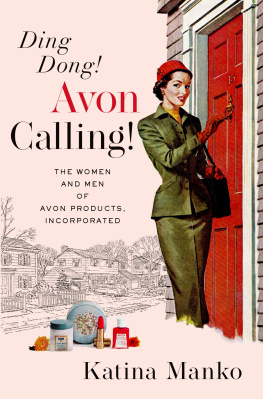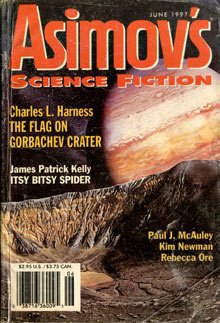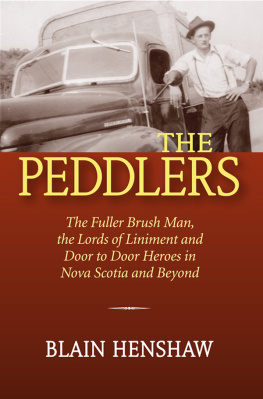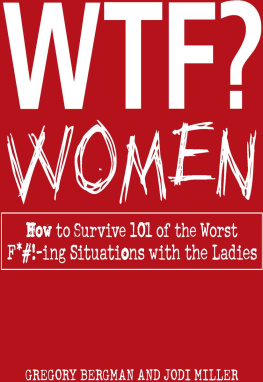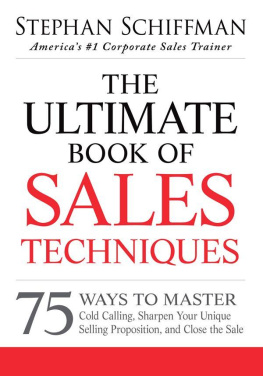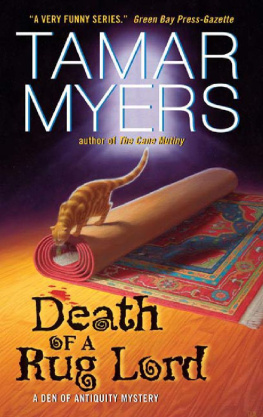Ding Dong! Avon Calling!

Oxford University Press is a department of the University of Oxford. It furthers the Universitys objective of excellence in research, scholarship, and education by publishing worldwide. Oxford is a registered trade mark of Oxford University Press in the UK and certain other countries.
Published in the United States of America by Oxford University Press
198 Madison Avenue, New York, NY 10016, United States of America.
Oxford University Press 2021
All rights reserved. No part of this publication may be reproduced, stored in a retrieval system, or transmitted, in any form or by any means, without the prior permission in writing of Oxford University Press, or as expressly permitted by law, by license, or under terms agreed with the appropriate reproduction rights organization. Inquiries concerning reproduction outside the scope of the above should be sent to the Rights Department, Oxford University Press, at the address above.
You must not circulate this work in any other form and you must impose this same condition on any acquirer.
Portions of chapter 4 have previously been published in Katina L. Manko, A Depression-Proof Business Strategy: The California Perfume Companys Motivational Literature, in Beauty andBusiness: Commerce, Gender, and Culture in Modern America edited by Philip Scranton 2001 Routledge, pgs. 142168. Reproduced by permission of Taylor and Francis Group, LLC, a division of Informa, plc.
Library of Congress Cataloging-in-Publication Data
Names: Manko, Katina, author.
Title: Ding dong! Avon calling! : the women and men of Avon Products,
Incorporated / Katina Manko.
Description: New York, NY : Oxford University Press, [2021] |
Includes bibliographical references and index.
Identifiers: LCCN 2020058276 (print) | LCCN 2020058277 (ebook) |
ISBN 9780190499822 (hardback) | ISBN 9780190499846 (epub) |
ISBN 9780190499853
Subjects: LCSH: Avon Products, Inc. | Cosmetics industryUnited StatesHistory. |
SellingCosmeticsUnited StatesHistory. | Direct sellingUnited StatesHistory. |
Women sales personnelUnited StatesHistory.
Classification: LCC HD9970.5.C674 A9563 2021 (print) | LCC HD9970.5.C674
(ebook) | DDC 381/.456685506573dc23
LC record available at https://lccn.loc.gov/2020058276
LC ebook record available at https://lccn.loc.gov/2020058277
DOI: 10.1093/oso/9780190499822.001.0001
For Gary, Sylvia, and Juliet
Contents
This book began as a dissertation at the University of Delaware, where I had received a generous and long-standing fellowship from the Hagley Museum and Library to study history, business, and technology. Thank you to Arwen Mohun, Roger Horowitz, Anne Boylan, Phil Scranton, and Kathy Peiss, all of whom served on my committee.
I owe enormous thanks to the Avon Corporation. When I decided to write about Avon, I knew I would have to access their corporate archives. I called their headquarters on and off for months to ask about historical records, only to be told that none were available, and usually received only a public relations packet in the mail. But one day I asked the receptionist if I could speak to the Avon archivist, and to my utter delight she said, We dont have archives anymore. Taking a closer look at the Avon board of directors, I focused on Cecily Selby, listed as a professor of Science Education at New York University, and wrote to her directly, as a fellow academic, explaining my interest in writing a history of the company. She forwarded my information to Jim Preston, Avons CEO. And twenty-four hours after that, I got a call from Prestons secretary to make an appointment to visit them New York City. I was shown to the back of a mail room where about fifty boxes of archival material had been kept, including a complete run of color catalogs dating from the early 1900s, and was given an office on the twenty-second floor where I worked for several months. As a Hagley Fellow, and knowing Hagleys interest in business manuscripts and their love of beautiful trade catalogs, I asked Michael Nash, the late director of the Hagley Archives, to see the collection. One year later, the Avon archive was moved toWilmington, Delaware, and to my great good fortune, I was hired as an archival assistant to process the records in it. (To anyone who uses the manuscript collection, thats my handwriting on all those folders.) I owe enormous thanks to the late Lynn Catanese and Michael Nash for securing this incredible collection and supporting my research, and to Roger Horowitz at the Hagley Center for the History of Business, Technology and Society, who has always ensured that Ive had access to Hagleys intellectual, financial, and staff support. Thank you to Kevin Martin who created the digital images and secured permission from Avon to use them. And to Carol Lockman, who continues to make every single visit to Hagley a happy adventure.
To my friends from graduate school who made it all bearableJan Davidson, Connie Anderton, Gary Ralph, Christine Sears, John Davies, Katie Leonard, and Alan Meyerthank you from the bottom of my heart. And thanks to my colleagues at the Business History ConferenceJeff Hornstein, Kevin Reilly, Tracey Deutsch, Sharon Murphy, and Stephanie Dyeras well as the impressive number of people who made valuable and kind comments on my papers, especially Maura Doherty, Mary Yeager, Susan Yohn, Wendy Gamber, Mary Yates, Geoff Jones, and Angel Kwolek-Folland. Debra Michals at Merrimack College has been my generous friend, supporter, and confidant for many years, and I value every step we have made together toward writing our books.
I am grateful to Niko Pfund at Oxford University Press for doggedly sending me email inquiries when this project on Avon Ladies was still young and for remembering me when I finally answered years later. I am especially thankful to him for forwarding my manuscript to Susan Ferber, the most patient, professional, and encouraging editor a reluctant writer like me could ask for. The valuable comments of three anonymous reviewers helped to reshape several chapters and expanded the scope of the book for the better.
Finally, this book would have never been finished without the fervent support and constant, unrelenting, and unbounded exasperation and pleading of my husband, Gary Mitchell. Gary read every word of this manuscript a dozen times. He helped edit every page and spent long days at the table outside this past summer inputting revisions. A writer himself, he actually thinks this has been fun and is already offering to help write the next book, but I forgive him. I hope that our amazing children, Sylvia and Juliet, will develop their voices and their art with as much grit and determination. They will have all the loving support our family can muster.
Ding Dong! Avon Calling!
Ding Dong! Avon Calling! A whole generation of Americans can sing those words to the tune of a two-chime doorbell. The Avon Lady was made famous in the 1950s by the legion of suburban women who rang doorbells and gave away tiny lipstick samples shaped like bullets. Some would know the Avon Lady through a stack of catalogs left in a staff lounge or on a counter at the beauty shop. Today, the Avon Lady most likely appears as an e-representative through a webpage who, if requested, will personally deliver beauty and cosmetics products right to your door.

